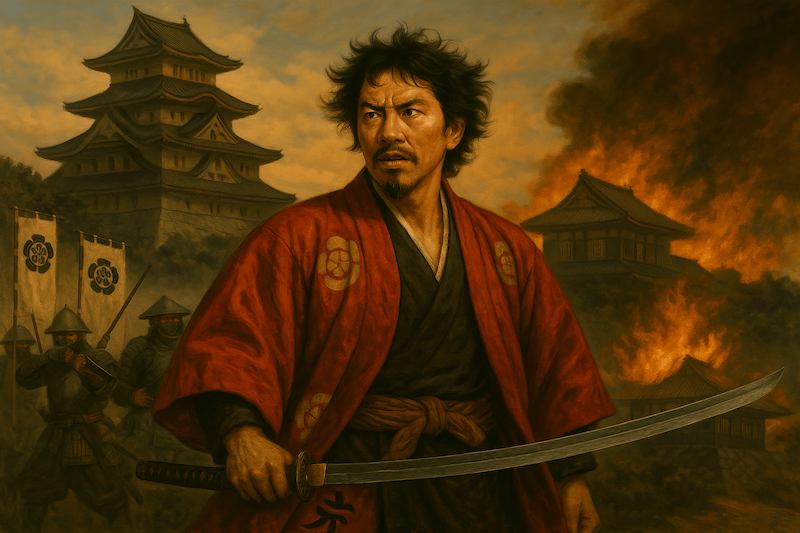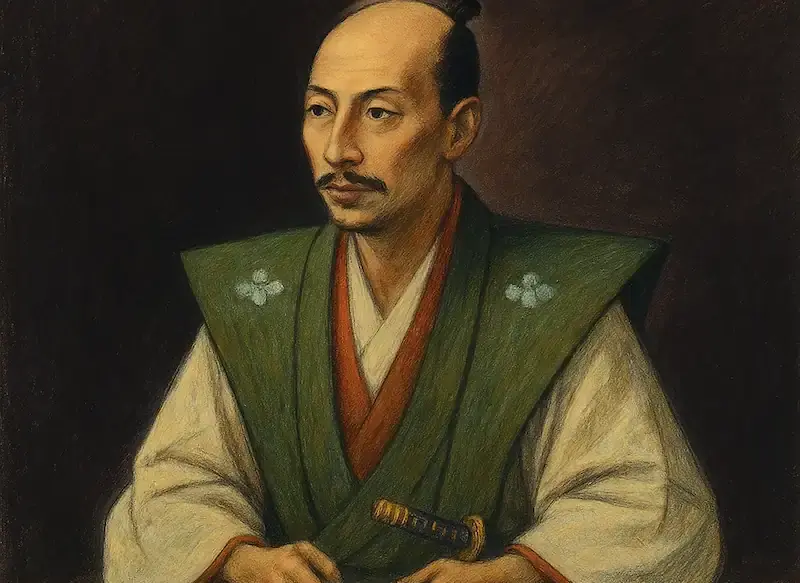
- The Life of Oda Nobunaga
- Early Life and the Unification of Owari
- Tenka Fubu and Military Reform
- Conflict with Religious Powers and the Destruction of Mount Hiei
- Azuchi Castle and Nobunaga’s Cultural Vision
- The Honnō-ji Incident – The Mysterious Death of Oda Nobunaga
- Oda Nobunaga and Shōgun: The Legacy of Kuroda Nobuhisa
- From History to Screen: Meet Kuroda Nobuhisa
- Return to the Oda Nobunaga Page
The Life of Oda Nobunaga
Oda Nobunaga (1534–1582) stands as one of the most radical and visionary warlords of Japan’s Sengoku period. A relentless breaker of tradition, Nobunaga sought not merely to conquer, but to redefine the very order of his time. Though often branded as ruthless, his uncompromising drive was a powerful force that pushed Japan toward unification and the end of centuries of civil war.
From inheriting his clan leadership to launching his ambitious campaign for national domination under the slogan Tenka Fubu (“Rule the Realm by Force”), and ultimately meeting his dramatic end in the Honnō-ji Incident, Nobunaga’s life was marked by bold decisions and an uncanny foresight that consistently defied convention.
Early Life and the Unification of Owari
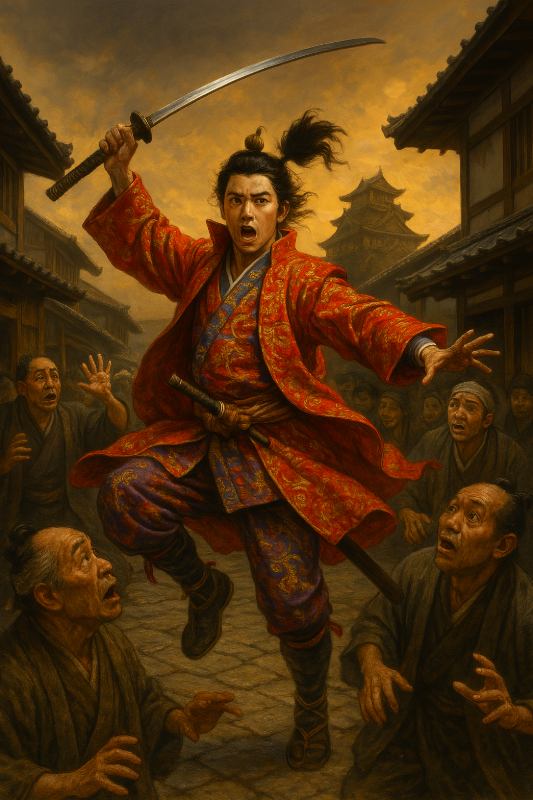
Oda Nobunaga was born in 1534 at Shobata Castle, located in the province of Owari—modern-day Inazawa City in Aichi Prefecture. His childhood name was Kippōshi. As a youth, he gained a reputation for eccentric behavior and was often dismissed as a fool (utsuke-mono). Yet beneath that erratic exterior lay a fiercely independent mind and a powerful sense of leadership that refused to be constrained by convention.
After the death of his father, Oda Nobuhide, Nobunaga assumed leadership of the Oda clan. He began to assert his dominance by confronting both internal rivals and external enemies within and beyond Owari. His dramatic breakthrough came in 1560 with the Battle of Okehazama, where he defeated the vastly superior forces of Imagawa Yoshimoto with a small, strategically deployed army. This audacious victory catapulted Nobunaga to national prominence and marked a pivotal turning point in his rise to power.
Tenka Fubu and Military Reform
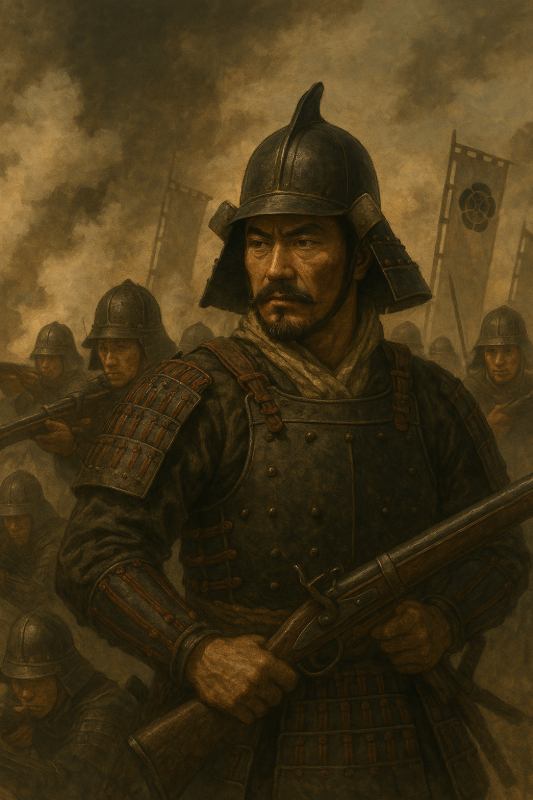
Oda Nobunaga adopted the seal Tenka Fubu, meaning “Rule the Realm by Force,” as a symbolic declaration of his intention to unify Japan through military strength and bold innovation. In a time when regional warlords vied for power with limited scope, Nobunaga’s use of this phrase was revolutionary—it wasn’t merely a motto, but a political statement that redefined his authority as transcending local rule. By stamping official documents and equipment with this seal, he signaled both his legitimacy and his sweeping ambition to dominate the entire nation under a new, centralized order.
To realize this vision, Nobunaga modernized the very nature of warfare. He aggressively integrated firearms into his tactics, streamlined troop mobility and supply lines, and prioritized efficiency in the training, equipment, and deployment of his soldiers. His reforms marked a significant shift from traditional samurai warfare to a more coordinated, strategic form of combat.
At the Battle of Nagashino in 1575, Nobunaga famously defeated the cavalry forces of the Takeda clan using what has long been known as the three-stage volley tactic (sandangi), in which gunners to sustain continuous fire. However, recent scholarship—such as the work of historian Stephen Turnbull—casts doubt on whether this technique was as structured as once believed. Instead, historians now suggest that Nobunaga’s arquebusiers likely maintained a continuous rate of fire through a more fluid, staggered shooting strategy—still a groundbreaking use of firearms in Japanese warfare.
Conflict with Religious Powers and the Destruction of Mount Hiei
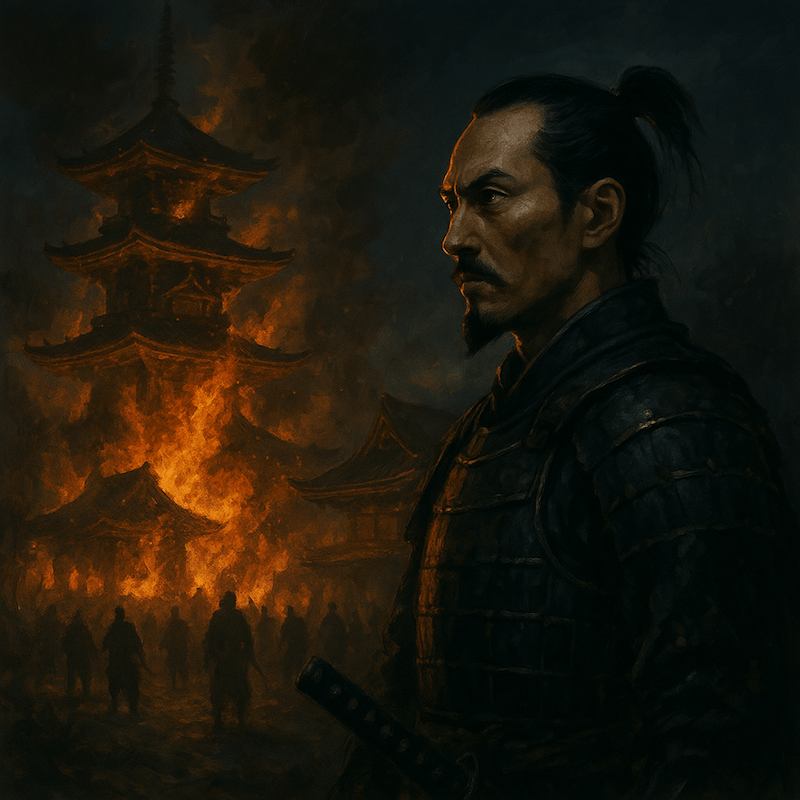
Oda Nobunaga’s rise to power during the Sengoku period brought him into direct conflict with the entrenched religious institutions that wielded significant political and military influence. Among these, the Tendai Buddhist monastery complex on Mount Hiei, known as Enryaku-ji, posed a formidable challenge. While revered as a spiritual center, Enryaku-ji had become deeply entangled in secular affairs, with some of its leadership allegedly involved in political machinations, including close ties to the Imperial Court and the acceptance of individuals through “amakudari” (descent from heaven) appointments. Reports from the time suggest that the temple’s internal dynamics were marred by corruption, with allegations of indulgence in wealth and the presence of women within the monastic community, deviating from traditional monastic codes.
In 1571, perceiving Enryaku-ji’s alliance with his adversaries and its potential threat to his authority, Nobunaga ordered a decisive military action against the monastery. His forces launched a comprehensive assault, resulting in the destruction of the temple complex and the loss of thousands of lives, including monks, laypeople, women, and children. This brutal campaign was not merely an act of religious persecution but a calculated move to dismantle a powerful institution that challenged his vision of centralized governance.
Nobunaga’s confrontations with religious powers extended beyond Mount Hiei. He engaged in a protracted conflict with the Ikkō-ikki, a militant Buddhist sect that had established a formidable base at Ishiyama Hongan-ji in present-day Osaka. The siege of this stronghold lasted approximately a decade, culminating in 1580 when the defenders, facing dwindling supplies and under pressure from both Nobunaga’s forces and an imperial decree, surrendered. Nobunaga allowed the occupants to evacuate before razing the fortress, effectively neutralizing a significant source of resistance.
These actions underscore Nobunaga’s commitment to consolidating power and eliminating autonomous entities that could undermine his authority. His aggressive stance against religious institutions was driven not by a disdain for faith itself but by a strategic imperative to curtail the political and military clout of religious organizations that operated beyond the purview of his emerging centralized state.
Azuchi Castle and Nobunaga’s Cultural Vision
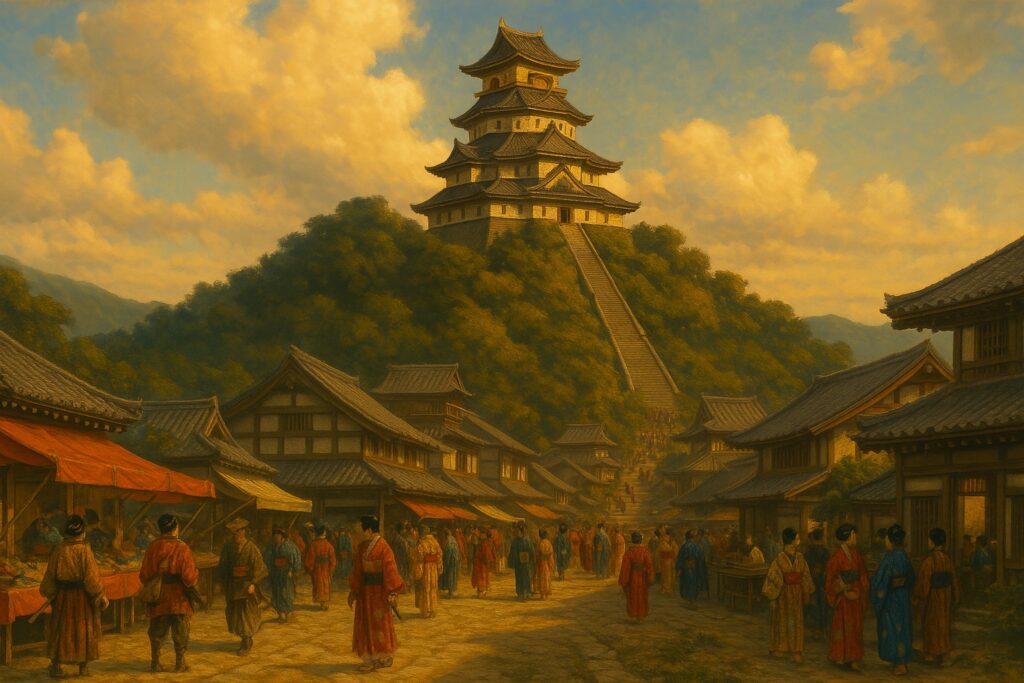
In 1576, Oda Nobunaga commenced the construction of Azuchi Castle atop Mount Azuchi in Ōmi Province (present-day Ōmihachiman, Shiga Prefecture). Completed three years later, the castle stood as a revolutionary departure from traditional mountaintop fortresses. Rather than serving solely as a military bastion, Azuchi Castle functioned as a political and cultural epicenter, embodying both authority and aesthetic sophistication.
The castle’s central tower—five stories tall externally and six internally—was adorned with opulent murals by renowned artists such as Kanō Eitoku, a famed painter of the Azuchi–Momoyama period, marking it as Japan’s first true tenshu (main keep). This architectural innovation set a new standard, blending grandeur with functionality.
Nobunaga’s cultural policies extended beyond architecture. He implemented the rakuichi-rakuza system—a free-market policy that abolished monopolies to encourage open commerce, thereby invigorating the local economy and fostering the development of a vibrant castle town. This approach laid the groundwork for urban planning models in the subsequent Edo period.
However, Azuchi Castle’s grandeur was short-lived. In 1582, shortly after Nobunaga’s death in the Honnō-ji Incident, the castle was burned down under mysterious circumstances. The exact cause remains uncertain, with theories ranging from accidental fire to deliberate arson by various factions. The destruction was so complete that no detailed architectural records survived, leaving historians to rely on limited contemporary accounts and archaeological findings to reconstruct its appearance.
Despite its brief existence, Azuchi Castle left an indelible mark on Japanese history. It symbolized a shift towards centralized power and cultural integration, reflecting Nobunaga’s vision of a unified and progressive nation. The castle’s innovative design and the policies it housed continue to influence Japanese architectural and urban development to this day.
The Honnō-ji Incident – The Mysterious Death of Oda Nobunaga
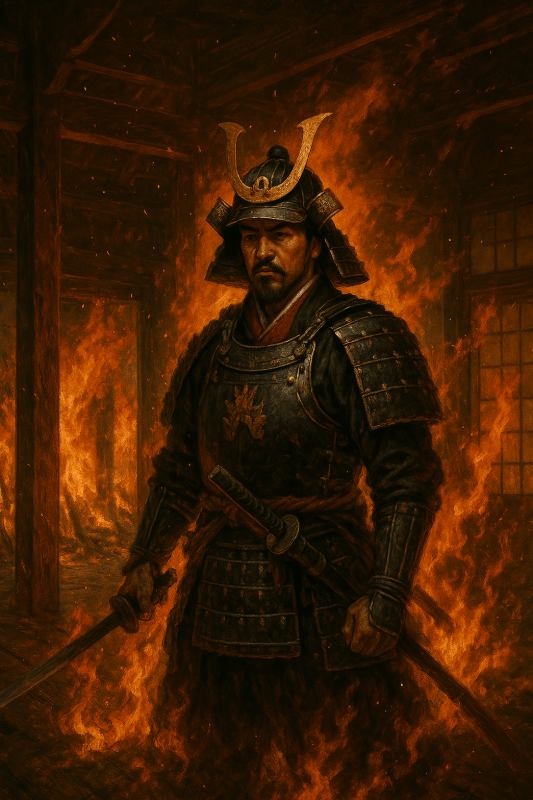
In 1582, while en route to lead a military campaign in western Japan, Oda Nobunaga was staying at Honnō-ji, a temple in Kyoto that served as one of his bases of operation. There, he was unexpectedly betrayed by one of his most trusted generals, Akechi Mitsuhide, in an event now known as the Honnō-ji Incident. With only a small contingent of guards and no time to summon reinforcements, Nobunaga chose to set the temple ablaze and commit ritual suicide rather than be captured. He was 49 years old.
The reasons behind Mitsuhide’s betrayal remain one of Japan’s enduring historical mysteries. While theories range from personal grievances and political ambition to external manipulation or ideological conflict, no definitive motive has ever been confirmed.
Contributing to the enigma is the unresolved disappearance of Nobunaga’s body from the charred ruins of Honnō-ji. Despite the intensity of the fire, many have questioned how such a prominent figure’s remains could vanish without a trace. This absence has fueled speculation for centuries—ranging from secret escape theories to symbolic interpretations of a death shrouded in myth.
Nobunaga’s sudden and dramatic demise shocked the nation. He had come within reach of unifying Japan under his rule, and his death created a power vacuum that could have plunged the country back into chaos. However, his legacy was carried forward by his successor, Toyotomi Hideyoshi, who swiftly avenged Nobunaga’s death by defeating Mitsuhide at the Battle of Yamazaki and ultimately completed the unification of Japan.
Even today, the Honnō-ji Incident remains a pivotal and mysterious chapter in Japanese history—an abrupt end to a revolutionary life, cloaked in flames and unanswered questions.
Oda Nobunaga and Shōgun: The Legacy of Kuroda Nobuhisa
In the FX series Shōgun, the character Kuroda Nobuhisa serves as a fictionalized embodiment of Oda Nobunaga, the renowned Sengoku-era warlord. Although Kuroda Nobuhisa is a fictional character in SHŌGUN, he is clearly modeled after Oda Nobunaga. He appears only briefly in the form of portraits and spoken references, but his legacy casts a powerful shadow over the political world of the drama—especially in the ambitions of Lady Ochiba and the rivalry between Toranaga and Ishido.
Kuroda is portrayed as a formidable yet controversial leader—ruthless, pragmatic, and unbound by tradition. This depiction mirrors historical accounts of Nobunaga, who was known for his revolutionary approach to warfare and governance. He challenged established norms, embraced Western technology, and implemented policies that disrupted the feudal order, all in pursuit of unifying Japan under his rule.
The series draws a striking parallel between Kuroda’s assassination by Akechi Jinsai and the historical betrayal of Nobunaga by Akechi Mitsuhide during the Honnō-ji Incident in 1582. Notably, the circumstances surrounding Nobunaga’s death remain shrouded in mystery, as his body was never found—a detail that adds to his enigmatic legacy.
By weaving elements of Nobunaga’s life into the character of Kuroda, Shōgun offers viewers a nuanced exploration of power, ambition, and the complexities of leadership during one of Japan’s most turbulent periods. This narrative choice enriches the series, providing depth and historical resonance that continue to captivate audiences worldwide.
From History to Screen: Meet Kuroda Nobuhisa
Return to the Oda Nobunaga Page
Click below to explore places associated with Oda Nobunaga.
